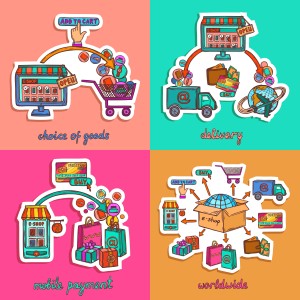Everyone knows that no matter what you’re looking for, the internet can provide it (or “knows a guy” who can). Supermarkets now strive to do likewise: You can find something beyond the usual in virtually every aisle. Think of it as precision shopping. And this isn’t just happening in the United States. Stores from São Paulo to Singapore are growing more international with every passing year.
It’s not hard to understand how this trend has evolved. Consider the thousands of companies doing business across international borders and the millions of employees routinely exposed to new cultures and cuisines.
This is the hidden side-effect of globalization, and it has changed how we eat and shop. (It’s also changed how corporations themselves shop; look at Hershey’s – headquartered in provincial rural Pennsylvania — recent $600 million acquisition of a Shanghai candy company). Culture and cuisine then influences niche TV programming across daytime talk shows and cable food networks.
 Suddenly, everyone knows what sriracha is. And they want some.
Suddenly, everyone knows what sriracha is. And they want some.
Now, in almost every urban supermarket, a shopper can find just about anything he or she wants, or don’t even know they want (and as costs continue to rise for ingredients, it’s notable that in some cases consumers appear willing to pay higher prices for the highly-specific products they want). The beer aisle now houses dozens of brands and brewing styles. In the US, we now have a burgeoning “craft soda” market. The craft influence has also taken over the condiment aisle. Count up the available brands of mustard, barbecue sauce, and hot sauce alone and you’ll run out of toes quickly.
Another aisle that has exploded with choice: Yogurt. It’s probiotics gone wild (and global): Greek. Kefir. Organic. Fruit on the bottom. Blended. And now arriving: Savory yogurts. Think garlic, dill, or cucumber.
And let’s not forget the ubiquity of hummus. How ubiquitous? You can find hummus in vending machines.
The products are only part of the story. They’re packaged and marketed to appeal to the consumer’s best self. On the package: Up-market, exclusive, artisanal, leveraging gender tropes (“guy food for the man cave”), etc. Inside the package: Pushing health trends, non-GMO, trans-fat-free, lower sodium, higher fiber, and more. The package itself: Recyclable, smaller footprint, Earth-friendly. Name the nutritional trend, and there’s a product exploiting it.
That trend also extends to frozen foods. As a sector, sales have declined. However, frozen foods with “real” ingredients have done well, reflecting consumers’ desire for healthier fare –perhaps because the message that flash-freezing techniques preserve nutritional integrity in all-natural foods has hit home. Another possibility: Frozen fruits and vegetables are reasonably priced and don’t spoil.
 (It’s interesting to note that this rise in packaged good diversity has coincided with an erosion in the private label market. Private label gained considerable shelf space during the Great Recession – understandably so – but has since ceded ground to the newer, the niche, and of course, the higher margin. This has led private label powerhouses such as ConAgra to turn away from that business in favor of their powerhouse consumer brands.)
(It’s interesting to note that this rise in packaged good diversity has coincided with an erosion in the private label market. Private label gained considerable shelf space during the Great Recession – understandably so – but has since ceded ground to the newer, the niche, and of course, the higher margin. This has led private label powerhouses such as ConAgra to turn away from that business in favor of their powerhouse consumer brands.)
Finally, true to the term globalization, the international aisle is now comparable to a cosmopolitan bazaar, with Peruvian, Pakistani, and Vietnamese choices claiming space alongside Chinese, Japanese, Thai, and Middle Eastern products. (And yes, you can still have the tacos and salsa). In a sense, if a nation or region exists, it has a cuisine, and you can find products of that cuisine on your local shelves.
This global exchange of ideas and trends should only continue as emerging markets with a growing middle class look to their own store shelves for the new and niche (Mondelēz, as just one example, made and sold more than 80 percent of its goods outside the U.S. and Canada in 2013). Some brands will always remain classics in their home countries – and embrace classic labeling to great effect (hello, Lite Beer from Miller) – but now that the internet has shown us that we can have anything we want whenever we want it, the packaged goods landscape looks a little different from the good ol’ days of … 2002?
